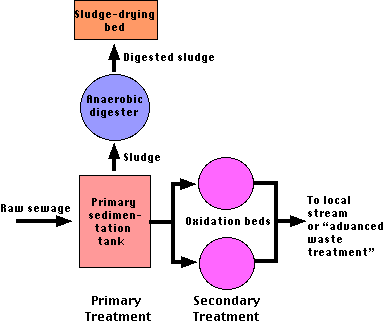| Index to this page |
The wastes generated by some 60% of the U.S. population are collected in sewer systems and carried along by some 14 billion gallons (~53 billion liters) of water a day. Of this enormous volume, some 10% is allowed to pass untreated into rivers, streams, and the ocean. The rest receives some form of treatment to improve the quality of the water (which makes up 99.9% of sewage) before it is released for reuse.

The simplest, and least effective, method of treatment is to allow the undissolved solids in raw sewage to settle out of suspension forming sludge. Such primary treatment removes only one-third of the BOD and virtually none of the dissolved minerals.
Attempts to use digested sludge as a fertilizer have been hampered by its frequent contamination by toxic chemicals derived from industrial wastes.
However, many treatment plants in North America then pass the effluent from primary treatment to secondary treatment. Here the effluent is brought in contact with oxygen and aerobic microorganisms. They break down much of the organic matter to harmless substances such as carbon dioxide.
Primary and secondary treatment together can remove up to 90% of the BOD. After chlorination to remove its content of bacteria, the effluent from secondary treatment is returned to the local surface water.
Several techniques are available to remove dissolved salts from sewage effluent, but all are quite expensive.
| Welcome&Next Search |